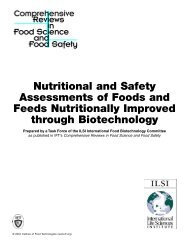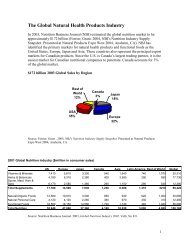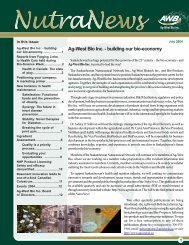Beyond Borders: Global biotechnology report 2010
Beyond Borders: Global biotechnology report 2010
Beyond Borders: Global biotechnology report 2010
Create successful ePaper yourself
Turn your PDF publications into a flip-book with our unique Google optimized e-Paper software.
and prevention of influenza in exchange<br />
for purchasing an 18% interest in the<br />
Netherlands-based company for US$443<br />
million. J&J also purchased 18% of Elan,<br />
receiving certain rights to Elan’s Alzheimer’s<br />
program. J&J agreed to provide US$500<br />
A closer look<br />
Valuing milestones<br />
million of further development funding for<br />
the program in addition to what was initially<br />
a US$1 billion payment for the equity<br />
interest in the Irish company.<br />
However, the deal was almost undone<br />
by a side agreement that would have<br />
The M&A environment was fraught with challenges in 2009.<br />
As the financial crisis unfolded, “valuation gaps” — chasms<br />
between the expectations of sellers and the realities of the<br />
market — opened up. To bridge these gaps, transactions<br />
frequently included contingent consideration such as payments<br />
upon the achievement of development or commercial<br />
milestones. In the US, a new accounting rule established by the<br />
Financial Accounting Standards Board (known as “SFAS 141R”)<br />
which became effective in 2009 requires such contingent<br />
consideration to be valued and accounted for prior to the<br />
resolution of the contingency.<br />
Under SFAS 141R, acquirers must estimate the fair value of<br />
the contingent consideration at the time of the acquisition.<br />
Buyers must also update that fair value every quarter until all<br />
contingencies are resolved.<br />
In determining a value for the contingent consideration,<br />
one challenging issue is the use of an appropriate discount<br />
rate for research stage milestones, which by their nature<br />
carry significant risk. Company disclosures have included<br />
discount rates ranging from 6% to 26% applied to probabilityadjusted<br />
payouts for technical milestones. Clearly, there is<br />
little consensus about the degree of risk accounted for in the<br />
probability adjustment and in the discount rate. It’s worth<br />
pointing out that there is less risk around a contingent payment<br />
than the associated research project because there is less<br />
uncertainty around the contingent payment than the ultimate<br />
cash flows associated with the project.<br />
The need to monitor and value contingent liabilities after the<br />
deal has closed creates additional challenges. There is the<br />
burden of updating timing, probabilities and forecasts on a<br />
quarterly basis. Any change in fair value flows through the<br />
allowed J&J to fund Elan’s acquisition<br />
of Tysabri rights from Biogen Idec if the<br />
Massachusetts-based company was ever<br />
subject to a change in control. After<br />
Biogen Idec protested in court claiming the<br />
side agreement violated its arrangement<br />
Michelle Mittelsteadt<br />
Ernst & Young LLP<br />
company’s income statement. When a research contingency is<br />
ultimately resolved, there could be a “loss” (if the research was<br />
successful and the contingent milestone liability is trued up to<br />
actual and paid) or a “gain” (if the milestone is not achieved<br />
and the related contingent liability is reversed). As a result,<br />
acquisitive companies will need to predict the “Day 2” impact on<br />
the financial statements from the time the deal is contemplated.<br />
One of the biggest changes in the new accounting guidelines is<br />
the capitalization rather than expensing of acquired in-process<br />
research and development projects (IPR&D). These assets<br />
are not amortized to expense until the R&D is completed and<br />
technical uncertainty is resolved, at which time the asset is<br />
amortized over its remaining useful life. Typically, the asset<br />
value is amortized after commercial launch.<br />
Given the new accounting treatment of these assets, there is<br />
far more scrutiny on the valuation of these projects, particularly<br />
in regard to the unit of account. For example, when a drug<br />
candidate is acquired, should the value be calculated on an<br />
aggregate basis for all indications for all geographies, or is it<br />
more appropriate to value separately each individual indication<br />
being pursued in each major regulatory geography? Clearly<br />
this becomes important when testing for impairment after<br />
the acquisition and when amortizing the asset. Over the first<br />
year of adoption, companies are still trying to determine their<br />
accounting policies in this matter, but there has been a trend<br />
toward consolidation on a global basis for a given indication,<br />
given the relative value of the major markets.<br />
Clearly, there are more valuation challenges under the<br />
new accounting standards, and acquiring companies must<br />
contemplate these challenges earlier in the deal process because<br />
the impacts on <strong>report</strong>ed financial results are long-lasting.<br />
79








